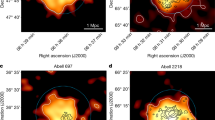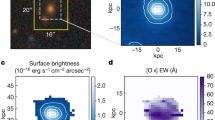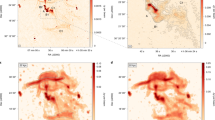Abstract
A redshift dependence of the maximum distance out to which active galactic nuclei (AGN) can transport their relativistic particles was first found for radio quasars by Miley1. He demonstrated that this distance was, on average, smaller in the past than it is at present, Analysing the run of median angular size with flux density for the entire extragalactic radio source population, Kapahi2 concluded that the radio galaxy population probably shares this property with the extended radio quasars. By using samples of radio ellipticals complete to vastly different flux limits, we can, for the first time, separate redshift- and luminosity-dependences of their linear sizes. Ram pressure in a medium with cosmologically varying density will naturally cause a dependence on redshift3, but this cannot explain so steep a dependence as that implied here. It may be expected if galaxy haloes influence the outward energy transport4.
This is a preview of subscription content, access via your institution
Access options
Subscribe to this journal
Receive 51 print issues and online access
$199.00 per year
only $3.90 per issue
Buy this article
- Purchase on Springer Link
- Instant access to full article PDF
Prices may be subject to local taxes which are calculated during checkout
Similar content being viewed by others
References
1. Miley, G. K. Mon. Not. R. astr. Soc. 152, 477–490 (1971). 2. Kapahi, V. K. Mon. Not. R. astr. Soc. 172, 513–533 (1975). 3. de Young, D. S. Astrophys. J. 167, 541–551 (1971). 4. Gopal–Krishna & Wiita, P. J. Mon. Not. R. astr. Soc. (in the press). 5. Hooley, A., Longair, M. S. & Riley, J. M. Mon. Not. R. astr. Soc. 182, 127–145 (1978). 6. Kapahi, V. K. Highlights of Astronomy (ed. Swings, J. P.) 371–376 (Reidel, Dordrecht, 1986). 7. Auriemma, C. et al. Astr. Astrophys. 57, 41–50 (1977). 8. Kron, R. G., Koo, D. C. & Windhorst, R. A. Astr. Astrophys. 146, 38–58 (1985). 9. Oort, M. J. A., Katgert, P., Steeman, F. W. M. & Windhorst, R. A. Astr. Astrophys. 179, 41 (1987). 10. Machalski, J. & Condon, J. J. Astr. J. 90, 973–986 (1985). 11. Gavazzi, G. & Perola, G. G. Astr. Astrophys. 66, 407–416 (1978). 12. Oort, M. J. A. thesis, Univ. Leiden (1987). 13. Katgert–Merkelijn, J., Lari, C. & Padrielli, L. Astr. Astrophys. Suppl. 40, 91–106 (1980). 14. Eales, S. A. Mon. Not. R. astr. Soc. 217, 179–203 (1985).
Author information
Authors and Affiliations
Rights and permissions
About this article
Cite this article
Oort, M., Katgert, P. & Windhorst, R. A direct determination of linear-size evolution of elliptical radio galaxies. Nature 328, 500–501 (1987). https://doi.org/10.1038/328500a0
Received:
Accepted:
Issue Date:
DOI: https://doi.org/10.1038/328500a0
This article is cited by
-
On the Unified Scheme of γ-Ray Emitting Jetted Active Galactic Nuclei
Astrophysics (2023)
-
On the unified scheme for high-excitation galaxies and quasars in 3CRR sample
Journal of Astrophysics and Astronomy (2019)
-
Linear size–extended radio luminosity (D–P E ) correlation in BL Lacertae objects: evidence for large scale beaming?
Astrophysics and Space Science (2013)
-
Redshift evolution of angular diameters and surface brightness: how rigid are galactic measuring rods?
Astrophysics and Space Science (2011)
-
Faint Young Sun, Planetary Paleoclimates and Varying Fundamental Constants
International Journal of Theoretical Physics (2005)
Comments
By submitting a comment you agree to abide by our Terms and Community Guidelines. If you find something abusive or that does not comply with our terms or guidelines please flag it as inappropriate.



